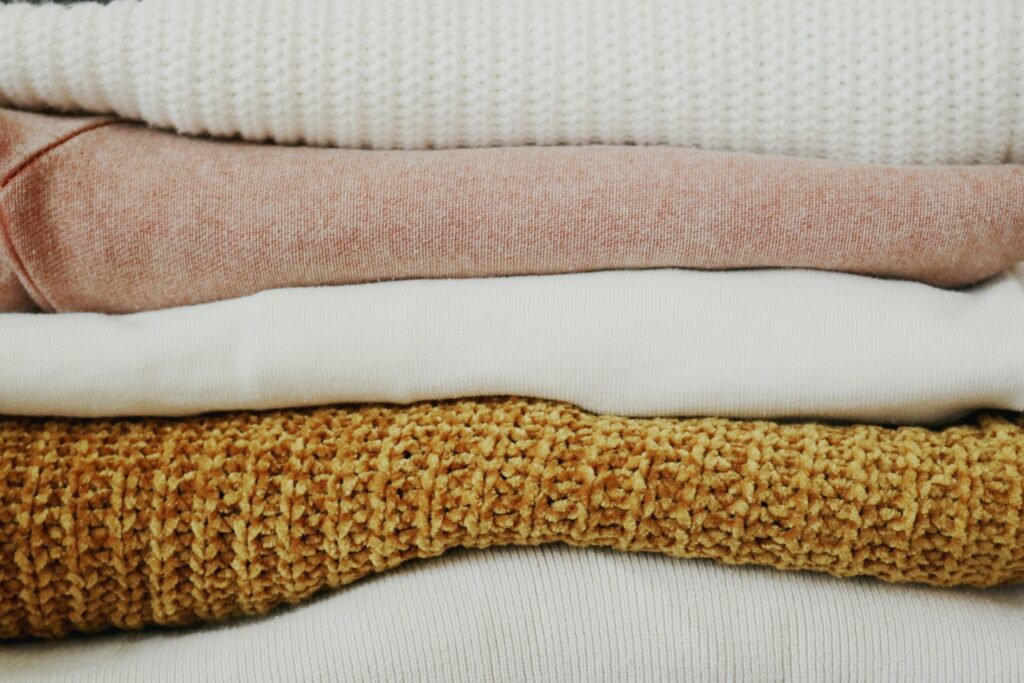A couple of years ago, my brother gifted me this amazing merino wool sweater. It was luxe, beautiful, and looked like a million bucks. The only problem – it was lime green in color.
I know my brother didn’t care about fashion, but I didn’t realize the extent of his disdain for clothes.
So anyway, I had to change the color of this merino wool garment. I decided to dye it, and the process turned out to be extremely easy.
In the end, I got a sweater that looked a lot less hideous, and the entire ordeal only cost me a few bucks, compared to the high price of a new merino wool sweater.
And that’s the step-by-step process that I am going to reveal in this article. Just follow these steps carefully, and you will be able to successfully dye merino wool:

1. Soak the merino wool garment in hot water
The first step in the dyeing process is preparing the vessel in which you would dye your merino wool clothes.
Pick a stainless steel or enamel pot that is large enough so that your clothes can roam around freely and be completely soaked. Fill it up with warm water.
Put this pot over a fire, or if you are using a gas stove, then turn on the heat. Throw in the merino wool garment which you want to dye. Remember to gradually increase the heat, because sudden changes in temperature can shock the wool and lead to felting.
During the entire dyeing process, we want the temperature of the water in the pot to be just below its boiling point. Higher temperatures are necessary to dye wool.
2. Add the dye to the pot and stir lightly
For dyeing merino wool, you would be requiring an acid dye. Acid dyes are usually found in powder form, but it is also possible to see them in liquid form. I recommend you get a starter kit, because it will have everything that you need. Here’s my favorite one:
- Starter set includes 4 colors and citric acid
- Mix colors to produce any color in the spectrum
- Citric acid fixes the dyes
- Made in the USA
Because each dye is different, it would be wise to follow the instructions that come with the dye in regard to the quantity needed per pound of dry fabric. As a rule of thumb, you would want to add 2-4% of the dry weight of the fabric in dye powder.
A simpler way to think of this is if you are dyeing 1 pound of fabric, you would need to use 1/3 to 2/3 of an ounce of dye. Slight deviations are completely okay and will not make much of a difference.
And the quantity of dye powder also depends on how saturated you want the finished piece to look. The higher the saturation, the higher quantity of dye needed.
3. Use vinegar to change the pH level of the dye bath
Because we are using acid dyes, the entire dyebath (the pot that contains your clothes and is being heated) can have a very wonky pH level – which is something that we don’t.
An unstable pH level makes dyeing very complicated. It hinders uniform dyeing and is overall a bad thing. To combat these unusual pH levels, we can use white vinegar.
Add 1/4 cup of vinegar per pound of fabric, and try to not pour it directly on the fabric. As an alternative, you can also add a tbsp of citric acid, which will also stabilize the pH levels of the dyebath.
And I will add an important note about stirring here. You shouldn’t be constantly stirring the merino wool, as that kind of felting can lead to agitation. Instead, stir only when necessary, and even then, try to go slow.
4. Let the pot heat for 20 minutes
Once all the ingredients are added in, it’s time to wait for the dye to do its job. Although related information will be printed on the back of your dye, on average, it takes about 20-30 minutes for merino wool to completely soak up the new color.
During this time of waiting, stir very occasionally. Otherwise, felting and shrinkage of the fabric can occur.
And once the 20 minute time period is over, just turn off the heat. Let your clothes stay in the dye bath until the entire thing comes down to room temperature.
Remember, we want to avoid sudden changes in temperature when dealing with merino wool. So don’t take out your clothes immediately from the pot.
5. Run your sweater under clear water and let it dry
For the final step, it is time to run your sweater through clear water. Preferably, the water should be at room temperature.
This step is to ensure that all the excess dye is being taken care of. The water will take out the dye that was unable to bond with merino wool fibers, and you need to keep doing this until the water runs clear.
Place your sweater on a flat table in a cool, dry place. Do not dry it in sunlight at this stage, as that can lead to color fading and discoloration.
You also do not want to hang up your sweater to dry. It is a bad practice in general, but it’s especially worse when the merino wool is wet.
Drying time can go up to days at this point. But once the garment is completely dry, you are free to wear it as and when you want.
What kind of dye to use for merino wool?
To dye merino wool, you will need to use an acid dye in the color of your choice. Acid dyes are used specifically for animal fibers, and therefore, a good quality acid dye is needed to change the color of a merino wool sweater.
There are numerous different dyes available nowadays. Some work better on plant-based fabrics, some work better on animal fibers, and some are just great all-purpose dyes.
If you want my personal recommendation, then I’ve had the most success with Jacquard dyes. These dyes, like RIT, don’t need additives. They also are pretty safe to handle, and unlike many commercial dyes, I have put them in my septic system with no issues.
You can find the brand on Amazon. Go for the color that’s most similar to what’s on your mind.
Does dyeing wool lead to shrinkage?
Dyeing merino wool can lead to shrinkage if the dyeing process is not done properly. Constantly stirring the clothes in the dyebath leads to agitation, which in turn leads to shrinkage.
See, acid dyes require heat to function properly. Extremely hot water is not great for merino wool, but the problem arises not in the temperature, but in the agitation.
It is the agitation that causes wool to felt and shrink. Most people tend to constantly poke or stir their clothing items in the dyebath, which leads to such problems.
To avoid shrinkage while dyeing wool, do not use a washing machine in the dyeing process. Use a tub that is big enough to contain your clothes, and do not poke or stir these clothes once they are in the dyebath.
Final Remarks
Dyeing your merino wool sweaters is a really easy way to reuse them. It promotes sustainability and adds an entirely new piece to your wardrobe for free. Therefore, if you are thinking of giving it a shot, here’s a step-by-step method to dye merino wool sweaters:
- Soak the merino wool in hot water in a big container.
- Add the dye to the pot and stir lightly.
- Use vinegar to change the pH level of the dyebath.
- Let the dyebath heat for 20-30 minutes.
- Run your sweater under clear water and let it dry.

My name is Alex Higson and I am the founder of Magic Of Clothes. I have worked in the fashion industry for many years, and clothes and style are a huge part of my life.

